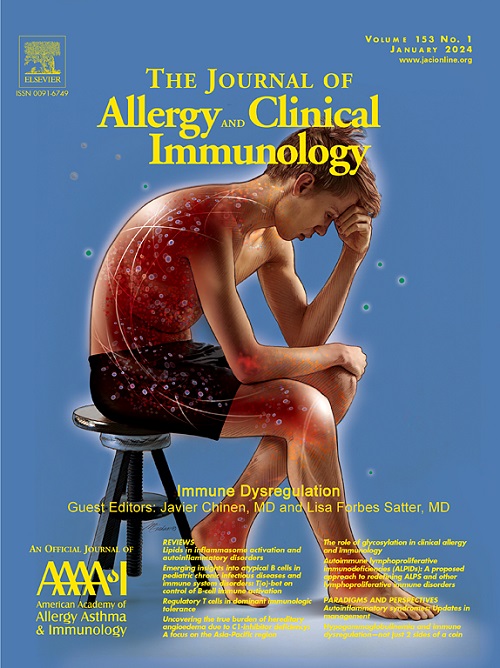Importance of mast cell histamine secretion in IgG-mediated systemic anaphylaxis
IF 11.4
1区 医学
Q1 ALLERGY
引用次数: 0
Abstract
Background
IgG can mediate murine and human systemic anaphylaxis (SA). The roles of mast cells (MCs) and histamine in IgG-mediated anaphylaxis are controversial for mice and have not been studied in vivo for humans. We are now investigating these issues.
Methods
Actively or passively sensitized wild-type and immune-deficient mice were induced to develop anaphylaxis by intravenous antigen challenge. Anaphylaxis was characterized by evaluating hypothermia, hypomobility, histamine, and MC protease responses.
Results
In contrast to our previous results with protein-immunized mice from a conventional colony, IgG-mediated passive SA in our specific pathogen-free colony mice depended considerably on histamine produced by connective tissue MCs (CTMCs) in response to FcγRIII crosslinking. This was found for C57BL/6 and young male and female BALB/c mice, including BALB/c mice newly arrived from 3 vendors. IgG-mediated anaphylaxis was less histamine dependent in old than young mice. Although both mucosal MC (MMC) and CTMC responses were severely depleted in c-kit–deficient mice, MMC responses depended considerably more than CTMC responses on c-kit for maintenance. In immunologically naive mice, FcγRIII crosslinking strongly activated a subset of CTMCs but had little ability to activate MMCs. In vivo LPS + poly I:C treatment decreased histamine dependence of IgG-mediated anaphylaxis, while a strong TH2 immune response increased FcγRIII crosslinking-induced MMC activation. IgG-mediated activation of human MCs in reconstituted immunodeficient mice induced histamine-dependent anaphylaxis.
Conclusion
IgG-dependent SA can be mediated largely by histamine released by mouse CTMCs and human MCs; histamine dependence is influenced by mouse age, sex, and immune and infectious history, as well as the anaphylaxis model studied.

肥大细胞组胺分泌在 IgG 介导的全身性过敏性休克中的重要性。
背景IgG 可介导小鼠和人类全身性过敏性休克(SA)。肥大细胞(MCs)和组胺在 IgG 介导的过敏性休克中的作用在小鼠中尚存争议,在人类中尚未进行体内研究。我们现在对这些问题进行研究:方法:通过静脉注射抗原诱导主动或被动致敏的野生型和免疫缺陷型小鼠发生过敏性休克。通过评估低体温、低运动性、组胺和肥大细胞蛋白酶反应来确定过敏性休克的特征:结果:与我们之前对来自传统群体的蛋白免疫小鼠的研究结果不同,SPF 群体小鼠的 IgG 介导的被动过敏性休克在很大程度上依赖于结缔组织肥大细胞(CTMC)对 FcγRIII 交联反应产生的组胺。C57BL/6 小鼠和年轻的雌雄 BALB/c 小鼠(包括刚从 3 个供应商处购买的 BALB/c 小鼠)都存在这种情况。老龄小鼠对组胺的依赖性低于幼龄小鼠。虽然c-kit缺陷小鼠的粘膜MC(MMC)和CTMC反应都严重衰竭,但MMC反应比CTMC反应更依赖于c-kit的维持。在免疫幼稚的小鼠中,FcγRIII 交联能强烈激活 CTMCs 的一个子集,但几乎不能激活 MMCs。体内 LPS + 聚 I.C 处理降低了 IgG 介导的过敏性休克对组胺的依赖性,而强烈的 Th2 免疫反应增加了 FcγRIII 交联诱导的 MMC 激活。IgG介导的重组免疫缺陷小鼠人MCs活化可诱导组胺依赖性过敏性休克:IgG依赖性过敏性休克主要由小鼠CTMC和人MC释放的组胺介导;组胺依赖性受小鼠年龄、性别、免疫和感染史以及所研究的过敏性休克模型的影响。
本文章由计算机程序翻译,如有差异,请以英文原文为准。
求助全文
约1分钟内获得全文
求助全文
来源期刊
CiteScore
25.90
自引率
7.70%
发文量
1302
审稿时长
38 days
期刊介绍:
The Journal of Allergy and Clinical Immunology is a prestigious publication that features groundbreaking research in the fields of Allergy, Asthma, and Immunology. This influential journal publishes high-impact research papers that explore various topics, including asthma, food allergy, allergic rhinitis, atopic dermatitis, primary immune deficiencies, occupational and environmental allergy, and other allergic and immunologic diseases. The articles not only report on clinical trials and mechanistic studies but also provide insights into novel therapies, underlying mechanisms, and important discoveries that contribute to our understanding of these diseases. By sharing this valuable information, the journal aims to enhance the diagnosis and management of patients in the future.

 求助内容:
求助内容: 应助结果提醒方式:
应助结果提醒方式:


